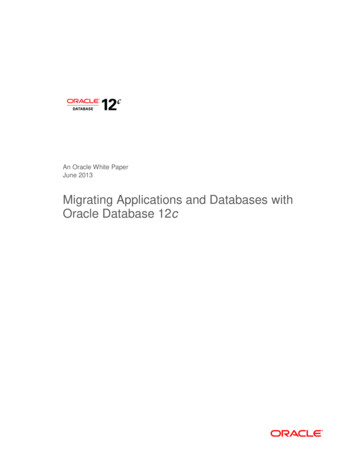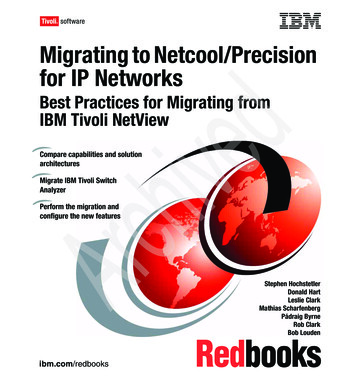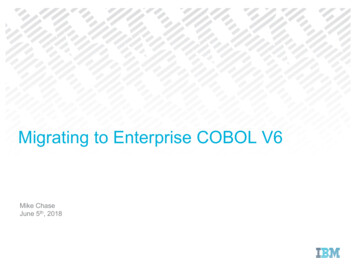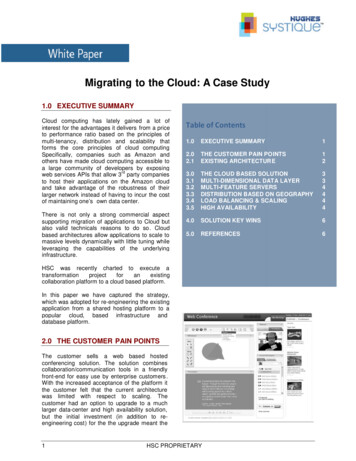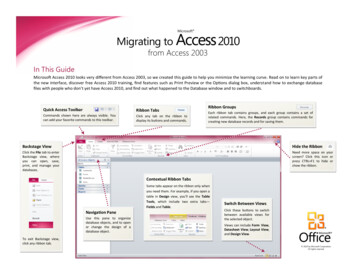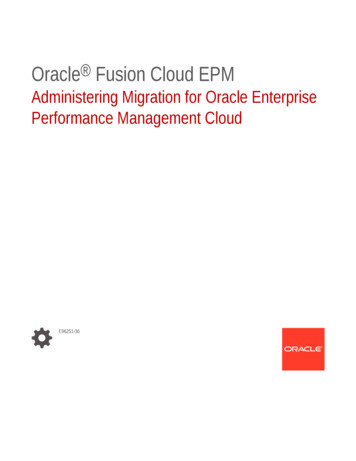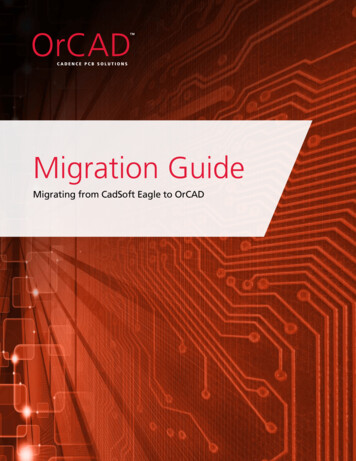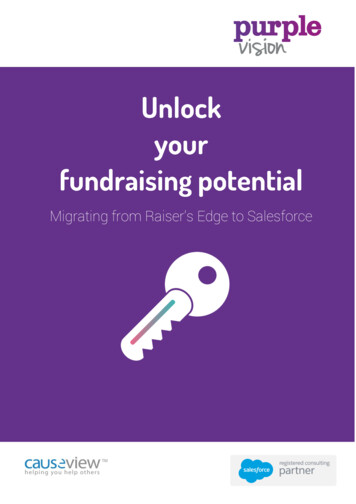
Transcription
Amazon Web Services - Migrating Your Existing Applications to the AWS CloudOctober 2010Migrating your Existing Applications to the AWS CloudA Phase-driven Approach to Cloud MigrationJinesh Variajvaria@amazon.comOctober 2010Page 1 of 23
Amazon Web Services - Migrating Your Existing Applications to the AWS CloudOctober 2010AbstractWith Amazon Web Services (AWS), you can provision compute power, storage and other resources, gaining access to asuite of elastic IT infrastructure services as your business demands them. With minimal cost and effort, you can moveyour application to the AWS cloud and reduce capital expenses, minimize support and administrative costs, and retainthe performance, security, and reliability requirements your business demands.This paper helps you build a migration strategy for your company. It discusses steps, techniques and methodologies formoving your existing enterprise applications to the AWS cloud. To get the most from this paper, you should have basicunderstanding of the different products and features from Amazon Web Services.There are several strategies for migrating applications to new environments. In this paper, we shall share several suchstrategies that help enterprise companies take advantage of the cloud. We discuss a phase-driven step-by-step strategyfor migrating applications to the cloud.More and more enterprises are moving applications to the cloud to modernize their current IT asset base or to preparefor future needs. They are taking the plunge, picking up a few mission-critical applications to move to the cloud andquickly realizing that there are other applications that are also a good fit for the cloud.To illustrate the step-by-step strategy, we provide three scenarios listed in the table. Each scenario discusses themotivation for the migration, describes the before and after application architecture, details the migration process, andsummarizes the technical benefits of migration:Scenario NameSolutionUse caseCompany AWeb ApplicationMarketing andcollaboration Web siteCompany BBatch processingpipelineBackend processingworkflowDigital AssetManagement SolutionClaims ProcessingSystemCompany CPage 2 of 23Motivation FormigrationScalability ElasticityAdditional BenefitsServices UsedAuto Scaling, pro-activeevent based scalingEC2, S3, EBS, SimpleDB,AS, ELB, CW, RDSFaster time to marketAutomation and improveddevelopment productivityBusiness continuity andOverflow-protectionEC2, EBS, S3, SQSLower TCO,RedundancyEC2, S3, EBS, AS, SQS, IE
Amazon Web Services - Migrating Your Existing Applications to the AWS CloudOctober 2010IntroductionDevelopers and architects looking to build new applications in the cloud can simply design the components, processesand workflow for their solution, employ the APIs of the cloud of their choice, and leverage the latest cloud-based bestpractices1 for design, development, testing and deployment. In choosing to deploy their solutions in a cloud-basedinfrastructure like Amazon Web Services (AWS), they can take immediate advantage of instant scalability and elasticity,isolated processes, reduced operational effort, on-demand provisioning and automation.At the same time, many businesses are looking for better ways to migrate their existing applications to a cloud-basedinfrastructure so that they, too, can enjoy the same advantages seen with greenfield application development.One of the key differentiators of AWS’ infrastructure services is its flexibility. It gives businesses the freedom of choice tochoose the programming models, languages, operating systems and databases they are already using or familiar with. Asa result, many organizations are moving existing applications to the cloud today.It is true that some applications (“IT assets”) currently deployed in company data centers or co-located facilities mightnot make technical or business sense to move to the cloud or at least not yet. Those assets can continue to stay inplace. However, we strongly believe that there are several assets within an organization that can be moved to the cloudtoday with minimal effort. This paper will help you build an enterprise application migration strategy for yourorganization. The step by step, phase-driven approach, discussed in the paper will help you identify ideal projects formigration, build the necessary support within the organization and migrate applications with confidence.Many organizations are taking incremental approach to cloud migration. It is very important to understand that with anymigration, whether related to the cloud or not, there are one-time costs involved as well as resistance to change amongthe staff members (cultural and socio-political impedance). While these costs and factors are outside the scope of thistechnical paper, you are advised to take into consideration these issues. Begin by building organizational support byevangelizing and training. Focus on long-term ROI as well as tangible and intangible factors of moving to the cloud andbe aware of the latest developments in the cloud so that you can take full advantage of the cloud benefits.There is no doubt that deploying your applications in the AWS cloud can lower your infrastructure costs, increasesbusiness agility and remove the undifferentiated “heavy lifting” within the enterprise. A successful migration largelydepends on three things: the complexity of the application architecture; how loosely coupled your application is; andhow much effort you are willing to put into migration. We have noticed that when customers have followed the step bystep approach (discussed in this paper) and have invested time and resources towards building proof of conceptprojects, they clearly see the tremendous potential of AWS, and are able to leverage its strengths very quickly.1Architecting for the Cloud: Best Practices Whitepaper - http://media.amazonwebservices.com/AWS Cloud Best Practices.pdfPage 3 of 23
Amazon Web Services - Migrating Your Existing Applications to the AWS CloudOctober 2010A Phased Strategy for Migration: Step By Step GuideFigure 1: The Phase Driven Approach to Cloud MigrationPhasesCloud Assessment Financial Assessment (TCO calculation)Security and Compliance AssessmentTechnical Assessment (Classify application types)Identify the tools that can be reused and the tools thatneed to be builtMigrate licensed productsCreate a plan and measure successProof of Concept Get your feet wet with AWSBuild a pilot and validate the technologyTest existing software in the cloudMoving your Data Understand different storage options in the AWS cloudMigrate fileservers to Amazon S3Migrate commercial RDBMS to EC2 EBSMigrate MySQL to Amazon RDSMoving your Apps Forklift migration strategyHybrid migration strategyBuild “cloud-aware” layers of code as neededCreate AMIs for each componentLeveraging the Cloud Leverage other AWS servicesAutomate elasticity and SDLCHarden securityCreate dashboard to manage AWS resourcesLeverage multiple availability zonesOptimization Page 4 of 23Optimize usage based on demandImprove efficiencyImplement advanced monitoring and telemetryRe-engineer your applicationDecompose your relational databasesBenefitsBusiness case for migration (Lower TCO, faster timeto market, higher flexibility & agility, scalability elasticity)Identify gaps between your current traditionallegacy architecture and next -generation cloudarchitectureBuild confidence with various AWS servicesMitigate risk by validating critical pieces of yourproposed architectureRedundancy, Durable Storage, Elastic ScalableStorageAutomated Management BackupFuture-proof scaled-out service-oriented elasticarchitectureReduction in CapEx in ITFlexibility and agilityAutomation and improved productivityHigher Availability (HA)Increased utilization and transformational impact inOpExBetter visibility through advanced monitoring andtelemetry
Amazon Web Services - Migrating Your Existing Applications to the AWS CloudOctober 2010The order of the phases is not important. For example, several companies prefer to skip Phase 1 (Assessment Phase) anddive right into Phase 2 (Proof of Concept) or perform Application Migration (Phase 4) before they migrate all their data(Phase 3).Phase 1: Cloud Assessment PhaseThis phase will help you build a business case for moving to the cloud.Financial AssessmentWeighing the financial considerations of owning and operating a data center or co-located facilities versus employing acloud-based infrastructure requires detailed and careful analysis. In practice, it is not as simple as measuring potentialhardware expense alongside utility pricing for compute and storage resources. Indeed, businesses must take amultitude of options into consideration in order to affect a valid comparison between the two alternatives. Amazon haspublished a whitepaper, The Economics of the AWS cloud2 to help you gather the necessary data for an appropriatecomparison. This basic TCO methodology and the accompanying Amazon EC2 Cost Calculator uses industry data, AWScustomer research, and user-defined inputs to compare the annual fully-burdened cost of owning, operating, andmaintaining IT infrastructure with the pay-for-use costs of Amazon EC2. Note that this analysis compares only the directcosts of the IT infrastructure and ignores the many indirect economic benefits of cloud computing, including highavailability, reliability, scalability, flexibility, reduced time-to-market, and many other cloud-oriented benefits. Decisionmakers are encouraged to conduct a separate analysis to quantify the economic value of these features.Pricing ModelOne-time UpfrontMonthlyAWSCo-loOn-SiteAWSCo-loOn-SiteServer Hardware0 00Network Hardware0 000Hardware Maintenance0 00 Software OS0 00Power and Cooling00 0 Data Center/Co-located Space0 0 0Administration0 Storage0 00Bandwidth0 Resource Management Software000 24X7 Support000 TotalTable 1: Cloud TCO Calculation Example (some assumptions are made)The AWS Economics Center provides all the necessary tools you need to assess your current IT infrastructure. After youhave performed a high-level financial assessment, you can estimate your monthly costs using the AWS Simple MonthlyCalculator by entering your realistic usage numbers. Project that costs over a period of 1, 3 and 5 years and you willnotice significant savings.2http://media.amazonwebservices.com/The Economics of the AWS Cloud vs Owned IT Infrastructure.pdfPage 5 of 23
Amazon Web Services - Migrating Your Existing Applications to the AWS CloudOctober 2010Security and Compliance AssessmentIf your organization has specific IT security policies and compliance requirements, we recommend that you involve yoursecurity advisers and auditors early in the process. At this stage, you can ask the following questions: What is my overall risk tolerance? Are there various classifications of my data that result in higher or lowertolerance to exposure? What are my main concerns around confidentiality, integrity, availability, and durability of my data? What are my regulatory or contractual obligations to store data in specific jurisdictions? What are my security threats? What is a likelihood of those threats materializing into actual attacks? Am I concerned about intellectual property protection and legal issues of my application and data? What are my options if I decide that I need to retrieve all of my data back from the cloud? Are there internal organizational issues to address to increase our comfort level with using shared infrastructureservices?Data security can be a daunting issue if not properly understood and analyzed. Hence, it important that you understandyour risks, threats (and likelihood of those threats), and then based on sensitivity of your data, classify the data assetsinto different categories (discussed in the next section). This will help you identify which datasets (or databases) to moveto the cloud and which ones to keep in-house. It is also important to understand these important basics regarding AWSSecurity: You own the data, not AWS. You choose which geographic location to store the data. It doesn’t move unless you decide to move it. You can download or delete your data whenever you like. You should consider the sensitivity of your data, and decide if and how you will encrypt your data while it is intransit and while it is at rest. You can set highly granular permissions to manage access of a user within your organization to specific serviceoperations, data, and resources in the cloud for greater security control.For more up-to-date information about certifications and best practices, please visit the AWS Security Center.Technical and Functional AssessmentA technical assessment is required to understand which applications are more suited to the cloud architecturally andstrategically. At some point, enterprises determine which applications to move into the cloud first, which applications tomove later and which applications should remain in-house.In this stage of the phase, enterprise architects should ask the following questions: Which business applications should move to the cloud first? Does the cloud provide all of the infrastructure building blocks we require? Can we reuse our existing resource management and configuration tools? How can we get rid of support contracts for hardware, software and network?Page 6 of 23
Amazon Web Services - Migrating Your Existing Applications to the AWS CloudOctober 2010Create a Dependency Tree and a Classification ChartPerform a thorough examination of the logical constructs of your enterprise applications and start classifying yourapplications based on their dependencies, risks, and security and compliance requirements.Identify the applications and their dependencies on other components and services. Create a dependency tree thathighlights all the different parts of your applications and identify their upward and downstream dependencies to otherapplications. Create a spreadsheet that lists all your applications and dependencies or simply “white-board” yourdependency tree that shows the different levels of interconnections of your components. This diagram should be anaccurate snapshot of your enterprise application assets. It may look something like the diagram below. It could includeall your ERP systems, HR services, Payroll, Batch processing systems, backend billing systems and customer-facing webapplications, internal corporate IT applications, CRM systems etc. as well as lower-level shared services such as LDAPservers.At this stage, you will have clear visibility into your IT assetsand you might be able to classify your applications intodifferent categories: Applications with Top Secret, Secret, or Public data setsApplications with low, medium and high compliancerequirementsApplications that are internal-only, partner-only orcustomer-facingApplications with low, medium and high couplingApplications with strict, relaxed licensing and so on.Figure 2: Example of whiteboard diagram of all the IT assets and its dependencies (Dependency Tree)Identifying the Right “Candidate” for the CloudAfter you have created a dependency tree and have classified your enterprise IT assets, examine the upward anddownward dependencies of each application so you can determine which of them to move to the cloud quickly.For a Web-based application or Software as a Service (SaaS) application, the dependency tree will consist of logicalcomponents (features) of the website such as database, search and indexer, login and authentication service, billing orpayments, and so on. For backend processing pipeline, there will be different interconnected processes like workflowsystems, logging and reporting systems and ERP or CRM systems.In most cases, the best candidates for the cloud are the services or components that have minimum upward anddownward dependencies. To begin, look for systems that have fewer dependencies on other components. Someexamples are backup systems, batch processing applications, log processing systems, development, testing and buildPage 7 of 23
Amazon Web Services - Migrating Your Existing Applications to the AWS CloudOctober 2010systems, web-front (marketing) applications, queuing systems, content management systems, or training and pre-salesdemo systems.To identify which are good candidates for the cloud, search for applications with under-utilized assets; applications thathave an immediate business need to scale and are running out of capacity; applications that have architecturalflexibility; applications that utilize traditional tape drives to backup data; applications that require global scale (forexample, customer-facing marketing and advertising apps); or applications that are used by partners. Deprioritizeapplications that require specialized hardware to function (for example, mainframe or specialized encryption hardware).Figure 3: Identify the right candidate for the cloudOnce you have the list of ideal candidates, prioritize your list of applications so that it helps you : maximize the exposure in all aspects of the cloud (compute, storage, network, database) build support and awareness within your organization and creates highest impact and visibility among the keystakeholders.Questions to ask at this stage: Are you able to map the current architecture of the candidate application to cloud architecture? If not, howmuch effort would refactoring require? Can your application be packaged into a virtual machine (VM) instance and run on cloud infrastructure or does itneed specialized hardware and/or special access to hardware that the AWS cloud cannot provide? Is your company licensed to move your third-party software used in the candidate application into the cloud? How much effort (in terms of building new or modifying existing tools) is required to move the application? Which component must be local (on-premise) and which can move to the cloud? What are the latency and bandwidth requirements? Does the cloud support the identity and authentication mechanism you require?Page 8 of 23
Amazon Web Services - Migrating Your Existing Applications to the AWS CloudOctober 2010Identify the Tools That You Can ReuseIt is important to research and analyze your existing IT assets. Identify the tools that you can reuse in the cloud withoutany modification and estimate how much effort (in terms of new development and deployment effort) will be requiredto add “AWS support” to them. You might be able to reuse most of the system tools and/or add AWS support veryeasily. All AWS services expose standard SOAP and REST Web Service APIs, and provide multiple libraries and SDKs in theprogramming language of your choice. There are some commercial tools that you won’t be able to use in the cloud atthis time due to licensing issues, so for those you will need to find or build replacements:1. Resource Management Tools: In the cloud, you deal with abstract resources (AMIs, Amazon EC2 instances,Amazon S3 buckets, Amazon EBS volumes and so on). You are likely to need tools to manage these resources.For basic management, see the AWS management Console.2. Resource Configuration Tools: The AWS cloud is conducive to automation, and as such, we suggest you considerusing tools to help automate the configuration process. Take a look at open source tools like Chef, Puppet, andCFEngine, etc.3. System Management Tools: After you deploy your services, you might need to modify your existing systemmanagement tools (NOC) so that you can effectively monitor, deploy and “watch” the applications in the cloud.To manage Amazon Virtual Private Cloud resources, you can use the same security policies and use the samesystem management tools you are using now to manage your own local resources.4. Integration Tools: You will need to identify the framework/library/SDK that works best for you to integrate withAWS services. There are libraries and SDKs available in all platforms and programming languages (See Resourcessection). Also, take a look at development productivity tools such as the AWS toolkit for Eclipse.Migrating Licensed ProductsIt is important to iron out licensing concerns during the assessment phase. Amazon is working with many third-partyISVs to smooth the migration path as much as possible. Amazon has teamed with a variety of vendors and is currentlyoffering three different options to choose from:1. Bring Your Own License (BYOL)Amazon has teamed with variety of ISVs who have permitted the use of their product on Amazon EC2. This EC2based license is the most friction-free path to move your software into the cloud. You purchase the license thetraditional way or use your existing license and apply it to the product which is available as a pre-configuredAmazon Machine Image. For example, Oracle, Sybase, Adobe, MySQL, JBOSS, IBM and Microsoft have made theirsoftware and support available in the AWS cloud using BYOL option. If you don’t find the software that you arelooking for in the AWS cloud, talk to your software vendor about making their software available in the cloud.The AWS Business Development Team is available to help you with this discussion.2. Use a Utility Pricing Model with a Support PackageAmazon has teamed with elite ISVs and they are offering their software as a Paid AMI (using the Amazon DevPayservice). This is a Pay-As-You-Go license in which you do not incur any upfront licensing cost and only pay for theresources you consume. ISVs charge a small premium over and above the standard Amazon EC2 cost which givesyou an opportunity to run any number of instances in the cloud for the duration you control. For example,RedHat, Novell, IBM, Wowza offer pay-as-you-go licenses. ISVs, typically, also offer a support package that goeswith pay-as-you-go license.Page 9 of 23
Amazon Web Services - Migrating Your Existing Applications to the AWS CloudOctober 20103. Use an ISV SaaS-based Cloud ServiceSome of the ISVs have offered their software as a service and charge a monthly subscription fee. They offerstandard APIs and web-based interfaces and are fairly quick to implement. This offering is either fully or partiallymanaged inside the AWS cloud. This option is often the easiest and fastest way to migrate your existing onpremise installation to a hosted on-demand offering by the same vendor or an equivalent offering by a differentvendor. In most cases, ISVs or independent third-party enterprise cloud services integrators offer migration toolsthat can help you move your data. For example, Mathematica, Quantivo, Pervasive and Cast Iron provide a SaaSoffering based on AWS.If your enterprise applications are tightly coupled with complex third-party enterprise software systems that have notyet been migrated to the AWS cloud or if you have already invested in multi-year on-premise licensing contracts withthe vendor, you should consider refactoring your enterprise applications into functional building blocks. Run what youcan in the cloud and connect to the licensed software systems that still run on-premise. Amazon VPC may be used tocreate an IPSec VPN tunnel that will allow resources running on AWS to communicate securely with resources at theother end of the tunnel in your existing data center. The whitepaper3 discusses several ways in which you can extendyour existing IT infrastructure to the cloud.Define Your Success CriteriaWhile you are at this stage, it is important to ask this question: “How will I measure success?”. The following table lists afew examples. Your specific success criteria will be customized to your organization’s goals and culture.Success CriteriaOldNewExamples on How to MeasureCost (CapEx) 1M 300K60% savings in CapEx over next 2 yearsCost (OpEx) 20K/Year 10K/YearHardware procurementefficiencyTime to market10 machines in 7months9 months100 machines in 5minutes1 monthServer-to-Staff ratio improved by 2x4 maintenance contracts discontinued3000% faster to get knownFlexibilityFixed StackAt least 99.99%uptimeAny StackNew opportunities10 projects backlog0 backlog, 5 newprojects identified80% faster in launching new products40% reduction in hardware-relatedsupport calls20% reduction in operational supportcallsNot locked into particular hardwarevendor or platform or technology25 new projects initiated in 3 monthsTable 2: Examples on how to measure success criteriaCreate a Roadmap and a PlanBy documenting the dependencies, creating a dependency tree, and identifying the tools that you need to build orcustomize, you will get an idea of how to prioritize applications for migration, estimate the effort required to migratethem, understand the one-time costs involved and assess the timeline. You can construct a cloud migration roadmap.Most companies skip this step and quickly move to the next phase of building a pilot project as it gives a clearerunderstanding of the technologies and tools.3http://media.amazonwebservices.com/Extend your IT infrastructure with Amazon VPC.pdfPage 10 of 23
Amazon Web Services - Migrating Your Existing Applications to the AWS CloudOctober 2010Phase 2: Proof of Concept PhaseOnce you have identified the right candidate for the cloud and estimated the efforts required to migrate, it’s time to testthe waters with a small proof of concept. The goal of this phase is to learn AWS and ensure that your assumptionsregarding suitability for migration to the cloud are accurate. In this phase, you can deploy a small greenfield applicationand, in the process, begin to get your feet wet with the AWS cloud.Get your feet wet with AWSGet familiar with the AWS API, AWS tools, SDKs, Firefox plug-ins and most importantly the AWS Management Consoleand command line tools (See the Getting Started Center for more details).At a minimum, at the end of this stage, you should know how to use the AWS Management Console (or the Firefox plugins) and command line tools to do the following:Upload an objectLearnAmazon S3Create a signedURLCreate a bucketCreate aCloudFrontDistributionCustomize AMIBundle AMILearn aboutSecurity GroupsTest differentAvailability ZonesLaunch acustomized AMILaunch AMILearnAmazon EC2Create Snapshotof a VolumeCreate EBSVolumeAttach VolumeRestore SnapshotCreate Elastic IPMap DNS toElastic IPTake a backupLearn AmazonRDSLaunch a DBInstanceScale up verticallyScale outhorizontally(more storage)SetupMulti-AZFigure 4: Minimum items to learn about services in a Proof of ConceptLearn about the AWS security featuresBe aware of the AWS security features available today. Use them at every stage of the migration process as you see fit.During the Proof of Concept Phase, learn about the various security features provided by AWS: AWS credentials, MultiFactor Authentication (MFA), authentication and authorization. At a minimum, learn about the AWS Identity and AccessManagement (IAM) features that allow you to create multiple users and manage the permissions for each of these userswithin your AWS Account. Figure 5 highlights the topics you need to learn regarding IAM:Page 11 of 23
Amazon Web Services - Migrating Your Existing Applications to the AWS CloudOctober 2010Create GroupsCreate a policyLearn aboutResources andConditionsCreate UsersGenerate newaccesscredentialsAssign users togroupsLearn IAMFigure 5: Minimum items to learn about security in a Proof of Concept PhaseAt this stage, you want to start thinking about whether you want to create different IAM groups for different businessfunctions within your organization or create groups for different IT roles (admins, developers, testers etc.) and whetheryou want to create users to match your organization chart or create users for each application.Build a Proof-Of-ConceptBuild a proof-of-concept that represents a microcosm of your application, or which tests critical functionality of yourapplication in the cloud environment. Start with a small database (or a dataset); don’t be afraid of launching andterminating instances, or stress-testing the system.For example, if you are thinking of migrating a web application, you can start by deploying miniature models of all thepieces of your architecture (database, web application, load balancer) with minimal data. In the process, learn how tobuild a Web Server AMI, how to set the security group so that only the web server can talk to the app server, how tostore all the static files on Amazon S3 and mount an EBS volume to the Amazon EC2 instance, how to manage/monitoryour application using Amazon CloudWatch and how to use IAM to restrict access to only the services and resourcesrequired for your application to functionMost of our enterprise customers dive into this stage and reap tremendous value from building pilots. We have noticedthat customers learn a lot about the capabilities and applicability of AWS during the process and quickly broaden the setof applications that could be migrated into the AWS cloud.In this stage, you can build support in your organization, validate the technology, test legacy software in the cloud,perform necessary benchmarks and set expectations.At the end of this phase, you should be able to answer the following questions: Did I learn the basic AWS terminology (instances, AMIs, volumes, snapshots, distributions, domains and so on)? Did I learn about many different aspects of the AWS cloud (compute, storage, network, database, security) bybuilding this proof of concept? Will this proof of concept support and create awareness of the power of the AWS cloud within the organization? What is the best way to capture all the lessons that I learned? A whitepaper or internal presentation? How much effort is required to roll this proof-of-concept out to production? Which applications can I immediately move after this proof of concept?After this stage, you will have far better visibility into what is available with AWS today. You will get hands-on experiencewith the new enviro
Amazon Web Services - Migrating Your Existing Applications to the AWS Cloud October 2010 Page 3 of 23 Introduction Developers and architects looking to build new applications in the cloud can simply design the components, processes and workflow for their solution, employ the APIs of the cloud of their choice, and leverage the latest cloud-based best
